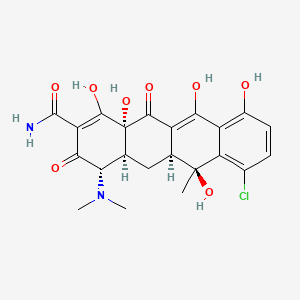| MeSH term | MeSH ID | Detail |
|---|---|---|
| Dermatitis Herpetiformis | D003874 | 1 associated lipids |
| Salmonella Food Poisoning | D012478 | 2 associated lipids |
| Pneumonia of Swine, Mycoplasmal | D045729 | 2 associated lipids |
| Epidermolysis Bullosa | D004820 | 3 associated lipids |
| Dry Socket | D004368 | 3 associated lipids |
| Treponemal Infections | D014211 | 3 associated lipids |
| Testicular Hydrocele | D006848 | 3 associated lipids |
| Anaplasmosis | D000712 | 3 associated lipids |
| Subacute Sclerosing Panencephalitis | D013344 | 3 associated lipids |
| Digital Dermatitis | D058066 | 3 associated lipids |
chlortetracycline
chlortetracycline is a lipid of Polyketides (PK) class. Chlortetracycline is associated with abnormalities such as Granulomatous Disease, Chronic, Infection, Ischemia, Cerebral Ischemia and Cerebral Infarction. The involved functions are known as Regulation, Binding (Molecular Function), Agent, Stimulus and Process. Chlortetracycline often locates in Protoplasm, Plasma membrane, Membrane, Cytoplasm and specific granule. The associated genes with chlortetracycline are FPR1 gene, P4HTM gene, Homologous Gene, HIST1H1C gene and Microbiome. The related lipids are Lysophosphatidylcholines, Sterols, dilauroyl lecithin, seminolipid and Total cholesterol. The related experimental models are Mouse Model.
Cross Reference
Introduction
To understand associated biological information of chlortetracycline, we collected biological information of abnormalities, associated pathways, cellular/molecular locations, biological functions, related genes/proteins, lipids and common seen animal/experimental models with organized paragraphs from literatures.
What diseases are associated with chlortetracycline?
chlortetracycline is suspected in Ischemia, Cerebral Ischemia, Cerebral Infarction, Granulomatous Disease, Chronic, Infection, Antibiotic resistant infection and other diseases in descending order of the highest number of associated sentences.
Related references are mostly published in these journals:
| Disease | Cross reference | Weighted score | Related literature |
|---|
Possible diseases from mapped MeSH terms on references
We collected disease MeSH terms mapped to the references associated with chlortetracycline
PubChem Associated disorders and diseases
What pathways are associated with chlortetracycline
There are no associated biomedical information in the current reference collection.
PubChem Biomolecular Interactions and Pathways
Link to PubChem Biomolecular Interactions and PathwaysWhat cellular locations are associated with chlortetracycline?
Visualization in cellular structure
Associated locations are in red color. Not associated locations are in black.
Related references are published most in these journals:
| Location | Cross reference | Weighted score | Related literatures |
|---|
What functions are associated with chlortetracycline?
Related references are published most in these journals:
| Function | Cross reference | Weighted score | Related literatures |
|---|
What lipids are associated with chlortetracycline?
Related references are published most in these journals:
| Lipid concept | Cross reference | Weighted score | Related literatures |
|---|
What genes are associated with chlortetracycline?
Related references are published most in these journals:
| Gene | Cross reference | Weighted score | Related literatures |
|---|
What common seen animal models are associated with chlortetracycline?
Mouse Model
Mouse Model are used in the study 'Chlortetracycline and demeclocycline inhibit calpains and protect mouse neurons against glutamate toxicity and cerebral ischemia.' (Jiang SX et al., 2005).
Related references are published most in these journals:
| Model | Cross reference | Weighted score | Related literatures |
|---|
NCBI Entrez Crosslinks
All references with chlortetracycline
Download all related citations| Authors | Title | Published | Journal | PubMed Link |
|---|---|---|---|---|
| Agga GE et al. | Effects of In-Feed Chlortetracycline Prophylaxis in Beef Cattle on Animal Health and Antimicrobial-Resistant Escherichia coli. | 2016 | Appl. Environ. Microbiol. | pmid:27736789 |
| Chang J | Does chlortetracycline ointment aid healing of a traumatic tympanic membrane perforation? | 2016 | Clin Otolaryngol | pmid:27121165 |
| Li W et al. | Proteomics Analysis Reveals a Potential Antibiotic Cocktail Therapy Strategy for Aeromonas hydrophila Infection in Biofilm. | 2016 | J. Proteome Res. | pmid:27110028 |
| Shi H et al. | Degradation of typical antibiotics during human feces aerobic composting under different temperatures. | 2016 | Environ Sci Pollut Res Int | pmid:27083910 |
| Kyselková M et al. | Characterization of tet(Y)-carrying LowGC plasmids exogenously captured from cow manure at a conventional dairy farm. | 2016 | FEMS Microbiol. Ecol. | pmid:27083193 |
| Li Y et al. | Dissipation kinetics of oxytetracycline, tetracycline, and chlortetracycline residues in soil. | 2016 | Environ Sci Pollut Res Int | pmid:27072037 |
| Khan MH and Jung JY | Ozonation of chlortetracycline in the aqueous phase: Degradation intermediates and pathway confirmed by NMR. | 2016 | Chemosphere | pmid:26963235 |
| Brown JD et al. | Surveillance for Pasteurella multocida in Ring-Necked Pheasants (Phasianus colchicus) After an Outbreak of Avian Cholera and Apparently Successful Antibiotic Treatment. | 2016 | Avian Dis. | pmid:26953951 |
| Zong L et al. | Mechanism of action of a novel recombinant peptide, MP1102, against Clostridium perfringens type C. | 2016 | Appl. Microbiol. Biotechnol. | pmid:26921181 |
| Ãlvarez-Guerrero A et al. | In vitro capacitation and acrosome reaction in sperm of the phyllostomid bat Artibeus jamaicensis. | 2016 | In Vitro Cell. Dev. Biol. Anim. | pmid:26744028 |
